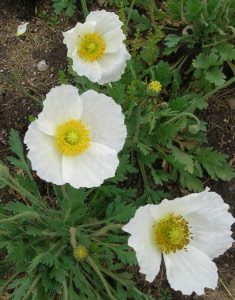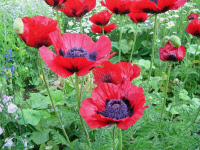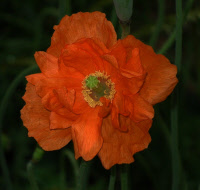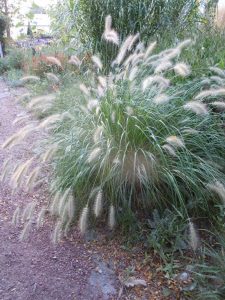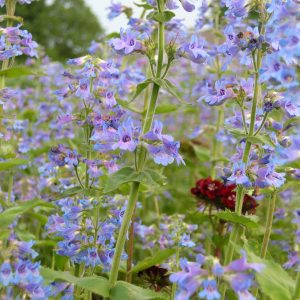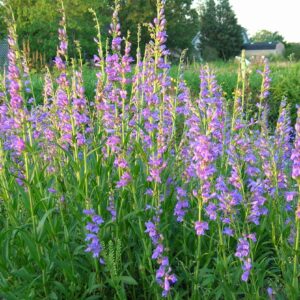Our Plants
Showing 409–416 of 587 results
-
Papaver anomalum alba Z 5-9
Paper thin petals on this pure white poppy with yellow stamens blooms May to October except in the heat of July.
Paper thin petals on this pure white poppy with yellow stamens blooms May to October except in the heat of July.
Size: 12” x 8”
Care: sun to part shade in well-drained soil. Deer resistant
Native: European AlpsAnomalum means extraordinary and this poppy is. Collected by 1909.
-
Papaver bracteatum Great scarlet poppy Z 5-8
Glossy fire engine red petals with black heart
OUT OF STOCK
Available for purchase in Spring only
Glossy fire engine red petals with black heart in June. D.M. Ferry Catalog, 1876: ”great beauty and magnificent.”
Size: 3-4’ x 3’
Care: sun in well-drained soil. Foliage dies back in summer & reemerges in the cool autumn. Drought tolerant and deer resistant.
Native: Siberia & Northern IranPapaver bracteatum was introduced to European gardens in 1817 from its native Siberia. Poppies have been grown since at least the time when Homer wrote the Illiad, in which he used the poppy’s hanging bud as a metaphor for a dying soldier. During World War I, Canadian soldier John McCrae again united the poppy with dying soldiers. He wrote “In Flanders’ Field.”
-
Papaver orientale Poppy Z 2-7
The classic poppy - papery tabasco petals with black blotch center in June. D.M. Ferry Catalog, 1876:"great beauty and magnificent.” It appears to die back in summer then the leaves reappear in fall.
Available for purchase in Spring only
The classic poppy – papery tabasco petals with black blotch center in June. D.M. Ferry Catalog, 1876: ”great beauty and magnificent.” It appears to die back in summer then the leaves reappear in fall.
Size: 2-3’ x 2’
Care: Full sun in well-drained soil.
Native: Caucasus
Wildlife Value: Deer resistant.Poppies have been grown since at least the time when Homer wrote the Illiad, in which he used the poppy’s hanging bud as a metaphor for a dying soldier. During World War I, Canadian soldier John McCrae again united the poppy with dying soldiers. He wrote “In Flanders’ Field.”
French botanist Joseph Pitton Tournefort (1656-1708) discovered this in Armenia in 1714 and sent it to the King of France. In 1741 Englishman Peter Collinson sent seeds to John Bartram who cultivated the plant in his Philadelphia nursery. Jefferson grew the oriental poppy at Monticello and Washington grew it at Mount Vernon. Acc’d to the Gardeners Dictionary, 1768 “There are two or three varieties of this which differ only in the colour of their flowers … and a double flower of this kind … Tournefort says, the Turks eat the green heads of this Poppy, although they are very bitter and acrid.” -
Papaver rupifragum Spanish poppy Z 5-9
Small crinkled, crepe-paper like apricot petals all summer & fall except for a recess in the heat of July. If you let them go to seed they will make more plants and you’ll be glad for it.
Small crinkled, crepe-paper like apricot petals all summer & fall except for a recess in the heat of July. If you let them go to seed they will make more plants and you’ll be glad for it.
Size: 12-18" x 8"
Care: sun in well-drained to moist well-drained soil. Deer resistant, drought tolerant
Native: Spain, Asia Minor & CaucasusFirst described in Journal of Botany in 1873. Louise Beebe Wilder considered this among her favorite perennials. (1918). One of our favorites too! Gertrude Jekyll, mother of the mixed perennial border planted this for its “rich apricot color.” (1908).
-
Parthenium integrifolium Wild Quinine Z 3-8
Work-horse white cymes July through October
Work-horse white cymes July through October
Size: 2-3’ x 12”
Care: sun in moist well-drained soil
Native: Mass. To Georgia & Minn. To Arkansas, incl. WI
Wildlife Value: provides nectar and pollen to native bees.Seeds are fragrant when crushed. Named “quinine” because it was used to treat fevers similar to malaria. Catawabe Indians used the leaves to treat burns and the flowers to treat fever. 1st described in literature in 1732.
-
Pennisetum orientale Oriental fountain grass Z 5-10
Showy, white to pinkish inflorescences summer thru fall.
Showy, white to pinkish inflorescences summer thru fall. Richard Darke, grass guru, describes this as “One of the most striking hardy fountain grasses. Low growing, compact and exceptionally floriferous … Blooms over an unusually long period from late June through October”
Size: 2' x 2'
Care: sun in well-drained soil or moist well-drained soil. Deer resistant and drought tolerant.
Native: central & SW Asia
Awards: Elisabeth Carey Miller Botanical Garden Great Plant PicksThe plant is named for its soft inflorescences; Latin penna and seta mean feather-bristle. This species collected before 1821.
-
Penstemon ovatus Beardtongue Z 4-9
Cornflower blue trumpets encircle spike in June, one of our favorites.
OUT OF STOCK
Cornflower blue trumpets encircle spike in June, one of our favorites.
Size: 2’ x 8”
Care: Full sun in well-drained soil
Native: Pacific Northwest
Wildlife Value: attracts Baltimore butterfly, bees, bumblebees, flies, wasps and hummingbirds.Penstemon is named for its five stamens, penta meaning five in Greek. Penstemons. Ovatus means oval, shaped like an egg, with the narrower end up, referring to the foliage. This species first collected by Scottish plant hunter David Douglas (1799-1834) and introduced in 1826.
-
Penstemon strictus Rocky Mountain penstemon Z 3-8
Spikes of deep purplish-red bells in summer
Spikes of deep purplish-red bells in summer.
Size: 30" x 24"
Care: Full sun in well-drained soil. Drought tolerant
Native: Wyoming to Arizona
Wildlife Value: feeds bees, hummingbirds and butterfliesPenstemon is named for its five stamens, penta meaning five and stemon meaning stamen in Greek. Strictus means “erect.” This species collected by explorer, military officer and politician John C Fremont (1813-1890) and described in 1846.

